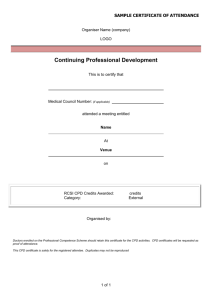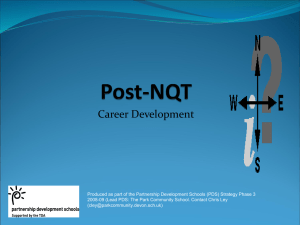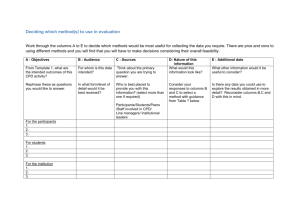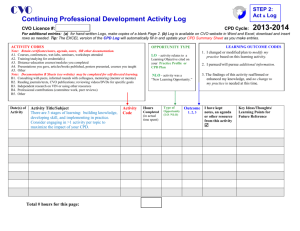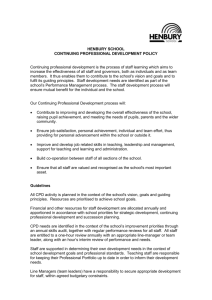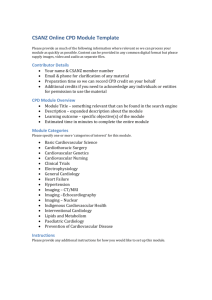Continuing Professional Development
advertisement
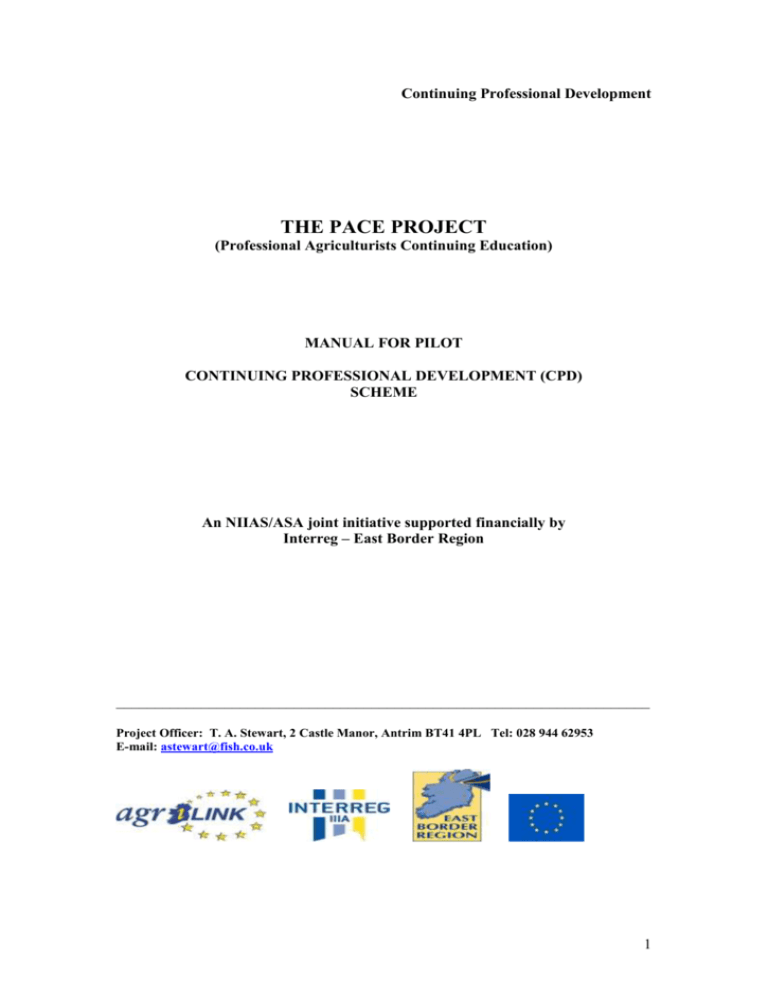
Continuing Professional Development THE PACE PROJECT (Professional Agriculturists Continuing Education) MANUAL FOR PILOT CONTINUING PROFESSIONAL DEVELOPMENT (CPD) SCHEME An NIIAS/ASA joint initiative supported financially by Interreg – East Border Region _____________________________________________________________________ Project Officer: T. A. Stewart, 2 Castle Manor, Antrim BT41 4PL Tel: 028 944 62953 E-mail: astewart@fish.co.uk 1 CONTENTS 2 ABOUT PACE The PACE (Professional Agriculturists Continuing Education) project is a joint initiative on behalf of NIIAS and ASA to improve the professional status of graduates working in Agriculture, Rural Development and Countryside Management. Its main aims are to (1) identify the training needs of graduates post CAP Reform by on-line survey (2) develop and pilot a common CPD (Continuing Professional Development) framework for use by the members of both Professional Bodies. Substantial funding has been secured from Interreg East Border Region to allow this ambitious 2-year project to be undertaken. INTRODUCING CPD Every time we act in a professional capacity, we make judgements based on our knowledge, skills and expertise. As competent professionals, we routinely maintain and update our expertise in ways appropriate to our role (advice, research, education, management) and consequently develop the attributes that enable us to act in a professional capacity. THE NIIAS/ASA CPD SCHEME Our CPD scheme is a framework that formally recognises an individual’s continuing professional development. It is designed to complement rather than duplicate existing employee schemes, particularly those that deal with personal performance and core organisational competencies. It revolves around the concept of Key Knowledge Areas (KA’s) of importance to graduates working in agriculture and related areas. These KA’s formed the basis of the training needs survey carried out in Spring 2005 and are now used to benchmark your continuing professional development. IMPORTANCE OF CPD Formal recognition of professional competence is important because of the increasing pressure within the workplace not only to achieve excellence, but also to show evidence of continuing competence and excellence at all stages of a career. Through this framework NIIAS and ASA are aiming to enhance the recognition, status and employability of its members and produce a mechanism by which individuals can demonstrate their credibility and distinctiveness. 3 Our scheme will enable members to - demonstrate their commitment to continuing professional development - provide support for appraisals and pay negotiations - record and control personal development activities - enhance their professional reputation and competitive edge APPROACH TO CPD Continual learning and consolidation of that learning is the key to CPD. Most Professionals advance their self-education as a matter of course and the NIIAS/ASA scheme has been designed to recognise this rather than add to your workload. It encourages a focused flexible approach to CPD by providing the necessary tools to establish your own personal development plan and to build up a portfolio of training activities. Activities already engaged in for other schemes will form valid contributions to the NIIAS/ASA scheme. THE CPD CYCLE The NIIAS/ASA scheme is based on a CPD cycle of analysis, planning, action, recording and review. (1) ANALYSIS – Assess your current role, identify training needs using KA’s as a guide, determine training goals in short and longer term (2) PLANNING – Identify formal and informal ways of achieving the skills/knowledge identified in Step 1 (consult training resource information for further assistance) (3) ACTION – Take part in formal and informal training identified in Step 2 (4) RECORDING - Note activities undertaken and retain relevant documentation/certification as part of your portfolio (5) REVIEW - evaluate progress towards meeting your training needs and note how you have benefited from training undertaken NB – The cycle involved in satisfying identified training needs may last weeks, months or years depending on the nature of the training undertaken. 4 THE CPD CYCLE ANALYSIS Assess your present situation Identify your goals Determine what skills are needed to achieve goals REVIEW & REFLECT Evaluate – have you made progress towards your goal? Have you benefited from the activities carried out and how? Note the benefits RECORDING Note activities undertaken Keep relevant documentation/ certification Together these form your portfolio PLANNING Identify formal and informal ways of acquiring the skills/ knowledge that you determined in the previous step ACTION Participate in the formal or informal CPD that you identified as necessary 5 THE TOOLS To support you through the stages of the CPD cycle, we provide tools that help you to plan your CPD and to record and reflect on the outcomes of your activities. Tools available in Section 2 of this pack: Three photocopiable forms with guidance: - Analysis & Planning to note your development needs and activities - Summary Form to record your achievements - Review & Reflect to note the benefits of your activity Questions to ask yourself at each stage Tools available on our website: - Key Knowledge areas appropriate to Professional Agriculturists - Links to educational/training sources. - Downloadable versions of the forms. Guidance and support are available from the PACE project Manager, Mr. Andrew Stewart, Tel. 028 9446 2953, e-mail: astewart@fish.co.uk TAKING PART IN CPD What Counts: Both formal and informal activities are suitable for inclusion in the NIIAS/ASA scheme. Formal activities could include accredited courses, other approved courses, Conferences, seminars and in-service training. Informal activities could include individual home study, e.g. using multimedia, planned reading and on-the-job learning. 6 How it counts: In order to make your CPD easier to record and measure, a points scheme has been devised, which accompanies the recording of outcomes. Two points per hour are given to formal activities, one point per hour for informal activities. Members undertaking CPD are expected to achieve a minimum of 40 points per year. Depending on your circumstances and opportunities, you may find that you substantially exceed this target. More detailed information on how to award yourself points is given in Section 2 under “Guidance on completing the analysis and planning form”. How to record your achievements: Your Portfolio As you progress through the scheme you can build up a portfolio. The content of your portfolio is up to you, as is the extent to which you use the tools provided. However, the portfolio is your most visible way of demonstrating your CPD commitment to others. You should take this into account when deciding its contents. Where possible, brief supporting evidence for the activities engaged in should be included in your portfolio e.g. a certificate of attendance, a reference to a technical paper, an article written or read. For further guidance on evidence, see p. in Section 2. A basic portfolio would contain: A completed summary form and supporting evidence for the main activities If you found completing the ‘Analysis and Planning’ and ‘Review and Reflect’ forms helpful, you may like to include these to demonstrate your systematic approach to your development. Monitoring CPD Maintaining a CPD portfolio is not presently a requirement of NIIAS/ASA membership. It would, however, become obligatory should both organisations decide to operate a register of CPD participants and if graded membership is introduced at some future date. It is intended that the initial scheme should be self-regulatory and consequently there is no formal requirement to submit summary forms annually to either organisation. If, however, you wish NIIAS/ASA to validate your CPD for other purposes e.g. to support appraisals/promotion negotiations/career change etc., you should submit your portfolio to the relevant Professional Body along with a small administrative fee (to be determined0. 7 FREQUENTLY ASKED QUESTIONS (FAQs) The following are questions that are frequently asked. If you have any queries about the scheme you may find the answer here. If you have further queries about CPD during the pilot phase of the PACE project, you may contact the project manager, Andrew Stewart, by e-mail: astewart@fish.co.uk or by telephone 028 9446 2953. Why should I do CPD? CPD is a useful process that adds value to your existing capabilities by demonstrating your commitment to your development. More and more people are engaging in CPD to demonstrate that they are keeping abreast of developments in their field. It improves your employability or promotion prospects and maintains flexibility for changing roles or career moves. The NIIAS/ASA scheme provides you with a framework for furthering your professional development and demonstrates to others that you take responsibility for your learning and competence. I’m used to taking opportunities to develop myself as and when they come up. Why should I make more work for myself by planning ahead and reflecting on it? Formally planning your CPD gives you better control of your development. Whilst opportunistic development has its own value, actively thinking about your needs, planning, recording and reflecting on them is a powerful learning tool. Formalising your development turns it even more to your advantage. It’s like going through your shelves at home to make a shopping list instead of shopping just when you are hungry. If you do the latter, you might impulse-buy items you don’t absolutely need and miss out on some essentials and end up paying more! How much CPD do I have to do? That is up to you. We ask that you complete enough CPD to gain 40 points a year. If you don’t manage this, then you can make it up the following year, in addition to completing that year’s credit. I’m already in a CPD scheme. How will I find time for NIIAS/ASA CPD too? Much of the NIIAS/ASA CPD concentrates on the knowledge based aspects of your work and should therefore complement rather than duplicate the more performance related schemes currently operated by employers. Many of the activities carried out for your existing CPD can count towards your NIIAS/ASA CPD and there are many other activities that you probably already do that would also count. 8 How do I get CPD credit? You get two points for each hour of formal CPD or one point for informal CPD. Why do I have to count CPD points ? Although the outcomes of CPD activity are most important to you, a measurable element is needed to complement this and provide a baseline points target to achieve. How do I record it? Simple on-line recording forms are provided for you to record the details on. These have been kept to the minimum but some space has also been included in which you should state how the activity has benefited you. Why do I have to keep records? It’s a waste of my time. Keeping records is an important part of a learning cycle and will help you identify strengths and those areas that still need development. Records are also your most visible way of proving your engagement with CPD and your professionalism. A CPD record can be useful support, e.g. during an appraisal. I’m doing some distance learning for a further qualification – will this count? Yes, this can count. Depending on your work, it can count as structured or unstructured. What counts as CPD? Basically, any activity that develops your work-related knowledge and skills counts as CPD. It can be formal (like attending conferences) or informal (like reading relevant journals). There are no hard and fast rules about what must be done, it is for you to decide what you need. If you are in doubt as to whether an activity counts towards CPD, consider how it would benefit/has benefited you. If you can demonstrate that it has enhanced your skills/knowledge relevant to your work, chances are it counts. What if I’m unemployed? CPD is not just for practising professionals; it’s a good way of showing potential employers that you take your development seriously, even when not employed. The NIIAS/ASA scheme accepts informal CPD as well as formal, there are, therefore, many opportunities to find activities that enhance your personal and management skills and maintain your technical knowledge abilities. The principles are the same; identify areas you would like to develop and methods of developing them, then evaluate their benefit. 9 SECTION 2. KEY KNOWLEDGE AREAS FOR PROFRESSIONAL AGRICULTURISTS NB – In defining the following key knowledge areas for Professional Agriculturists, it is assumed that the core sciences underpinning present day agriculture (e.g. biology, plant and animal physiology, genetics, soil science) have been studied to an appropriate level. A total of 7 key knowledge areas have been identified as relevant to Professionals working in the field of Agriculture, Rural Development and Countryside Management. These are sub-divided into sub-categories or elements in an attempt to describe the main areas in which graduates may become involved. It is recognised that the categories defined do not represent the last word on the subject and will change with time and the needs of the industry you serve. Hopefully they will provide you with a guide or prompt when deciding your training needs. The Key Knowledge Areas are as follows – 1. 2. 3. 4. 5. 6. 7. Livestock Production Crop Production Business Management Rural Development The Environment Personal Skills Miscellaneous Areas. 1. Livestock Production Element Description 1.1 Husbandry Techniques 1.2 Animal Nutrition 1.3 Grassland Management 1.4 Housing and Animal Welfare 1.5 Animal Medicines Have an up-to-date knowledge and be able to advise on livestock management systems for production of milk and meat including selection of breeds/crosses for individual situations. Have an up-to-date knowledge and able to advise on feed requirements and ration formulation making effective use of forages, cereals and other approved by-products Be able to advise on grass seed mixtures, grassland improvement, efficient use of organic and inorganic fertilisers, grazing management and grass conservation appropriate to the production system; production and conservation of alternative forages. Be conversant with current and proposed animal welfare regulations and be able to advise on appropriate building design to meet these requirements and that minimises the risk of air and water pollution. Be conversant with current Government regulations concerning the use of animal medicines and pesticides and be able to advise on their safe storage and the disposal of containers and residues. 10 1.6 Manure Storage and Disposal 1.7 Marketing Animal Products 1.8 Livestock Research Be conversant with current and proposed Government regulations concerning the collection, storage and disposal of animal manures and be able to advise on ways to maximise nutrient recovery and minimise pollution risk to air, water and soil. Have an up-to-date knowledge of market requirements for meat and milk and be able to advise on livestock system management to meet consumers’ demand, regulations concerning bio security, hygiene, transport and Quality Assurance Schemes. Be conversant with current livestock research and sources of information relevant to livestock production systems and be able to give a balanced view of research findings and their suitability for adoption under Irish conditions. 2. Crop Production 2.1 Husbandry Techniques 2.2 Crop Nutrition 2.3 Weed, Disease and Pest Identification and Control 2.4 Crop Mechanisation 2.5 Harvesting and Storage 2.6 Crops for Industrial Use 2.7 Crop Research 2.8 GM Crops Element Description Have an up-to-date knowledge of modern husbandry techniques and their application to individual crops of importance locally including grasses and be able to give advice on variety selection, seed bed preparation, plant growth and soil management Be able to advise in macro and micro nutrient requirements and efficient fertiliser usage to minimise environmental impact. Be able to recognise the main weeds, pests and diseases of crops and advise on the appropriate herbicide/pesticide usage consistent with current regulations and protection of the environment, including safe storage and disposal of containers and residues. Be conversant with current developments in crop mechanisation and be able to advise on machinery selection appropriate to local conditions. Be able to advise on the harvesting, drying and storage of crops for human and animal consumption, minimisation of wastage and adherence to Quality Assurance Schemes Have an up-to-date knowledge of and be able to advise on husbandry techniques required for crops grown for industrial use (e.g. cereal and rape crops for ethanol production, biomass crops such as willow, flax, hemp, miscanthus etc. for energy and fibre production.) Be conversant with current crop research and sources of information relevant to mainstream crops grown locally and to novel crops with future potential; be able to give a balanced view of research findings and their suitability for adoption under Irish conditions. Have an up-to-date knowledge of the pros and cons of growing genetically modified crops, their co-existence with conventional crops and organic production, and to be able to provide a balanced viewpoint on their adoption locally. 11 3. Business Management 3.1 Whole Farm and Enterprise Finances 3.2 Commercial Management 3.3 Business Planning & Administration 3.4 Tax Returns, VAT 3.5 CAP Reform 3.6 Application of IT Element Description Have an up-to-date knowledge of and be able to advise on techniques for assessing enterprise and whole farm profitability, including gross margin analysis, partial budgeting, cash flows, profit and loss accounts and the use of bench-marking Have an understanding/knowledge of business management principles and disciplines. Be capable of leading and managing businesses/business units. Be capable of formulating and implementing business strategy. Be capable of preparing or advising on the preparation of business plans, budgets, market research, market trends and the food supply chain. Be capable of organising/co-ordinating business resources and managing business operations. Have an understanding/knowledge of current tax regulations and be able to advise on and prepare tax and VAT returns. Have an understanding of CAP Reform and be able to advise on its application/implications for farming and the cross-compliance requirements and its impact on commercial & marketing activities & business related ancillary businesses. Have an up-to-date knowledge of the range of IT applications within the agrifood sector including enterprise recording and financial management software, decision support programmes and process management such as environmental control and livestock identification. 4. Rural Development 4.1 Support Funding 4.2 Diversification Projects 4.3 Start-up Businesses 4.4 Income Support 4.5 Theory and Practice of Rural Development. Element Description Have an up-to-date knowledge of Government and EU funded schemes to promote/encourage rural development and sustainability of rural communities and be able to give advice on their relevance to farming families Be familiar with opportunities for farm diversification projects (e.g. agri-tourism, equine activities, leisure pursuits) and be able to advise on their suitability to individual situations Be able to give advice to farmers on preparing business plans and undertaking market research in connection with diversification proposals. Have an understanding of different streams of government income support and benefits and be able to advise on applicability to rural dwellers. Have an understanding and knowledge of the principles of Rural Development and available support programmes and initiatives. 12 5. The Environment 5.1 CAP Reform 5.2 Water Quality & Pollution Control 5.3 Waste Management 5.4 Biodiversity/ Wildlife Conservation 5.5 Genetic Conservation 5.6 Landscape Conservation 5.7 Conservation of Historic Environment 5.8 GM Crops 5.9 Environmental Inspections 5.10 Geographical Positioning System Element Description Have an up-to-date knowledge of the environmental implications of CAP reform and be able to interpret and advise on their impact on local farming activities. Have an up-to-date knowledge of EU Directives and local legislation concerning pollution of air, water and soil (e.g. Nitrate, Water Framework, Ammonia emissions, SSAFO regulations) arising from farming activities and be able to advise on their interpretation/application; preparation of nutrient budgets and on actions required to minimise pollution risk. Have a knowledge of EU and local Government legislation/ Regulations dealing with agricultural wastes and use of agricultural land for waste disposal (e.g. animal by-products, packaging, IPPC, industrial wastes, sewage sludge) and be able to provide advice on their implementation. Have an up-to-date knowledge of Government schemes/ Regulations designed to promote/protect biodiversity; be capable of undertaking habitat surveys involving plant species identification and basic ornithological skills; be able to advise on farming practices that encourage/promote biodiversity. Have knowledge of and be capable of giving advice on preservation of traditional genetic sources such as traditional livestock breeds, crop varieties and conservation of rare wild plants. Have a knowledge and awareness of countryside character area descriptions (landscape assessments) and be able to advise farmers on how farming activities can have positive or negative impacts on local landscape characteristics Have knowledge of legislation to protect the historic environment (including scheduled Ancient Monuments, traditional farm buildings, listed buildings and parks) Have an up-to-date knowledge of the pros and cons of growing genetically modified crops and provide a balanced viewpoint on their environmental impact if adopted locally. A knowledge of GM technology, approval and release procedures for GM seeds, GM crop production and commercialisation. Have the necessary knowledge and training to carry out official inspections in relation to environmental schemes and pollution control Have an up-to-date knowledge of the use of Geographical Positioning System for farming and environmental activities. 13 6. Personal Skills 6.1 IT 6.2 Communication/ Networking 6.3 Evaluating Information 6.4 Managing Others 6.5 Managing Self 6.6 Project Management 6.7 Negotiating & Influencing Skills 6.8 Innovation and Change 6.9 Customer Focus Element Description Be fully conversant with basic computer skills (i.e. word processing, spreadsheets, databases, emailing, internet, Powerpoint) and be capable of applying them to my work Be able to present technical and other information in a clear concise manner (both written and orally) when delivering lectures, talks, writing press articles and preparing reports. Foster timely and high quality information flows between self and others Have a sound knowledge of research procedures – how to evaluate/interpret research findings, and to gather and evaluate information from a variety of sources, demonstrate sound practical judgement and decisiveness when evaluating the benefits and consequences of advice given, based on the available information. Know how to provide leadership, chair farmers’ meetings, community groups, set achievable objectives, influence others, understand group dynamics and achieve defined outcomes when working in a group situation. Be able to set clear achievable objectives while maintaining high professional, ethical and personal integrity standards; be able to manage time effectively and exhibit strong commitment to continuous learning as a means of personal improvement and raising/maintaining professional standards. Be able to manage projects, using appropriate knowledge, skills and techniques, balancing competing demands for scope, time, cost and risk to satisfy stakeholders and meet identified requirements. Have an understanding of formal project management methodologies. Be capable of effective negotiation. Be capable of asserting own ideas and persuading others; gain support and commitment from others; mobilising people to take action. Challenge norms and champion new innovations/initiatives; act as a catalyst for change and stimulate others to change; pave the way for change; manage change implementation process Be capable of anticipating and interpreting customer needs; take action to meet customer needs; continually search for ways to increase customer satisfaction. 14 7. Miscellaneous Areas 7.1 Education programme delivery 7.2 Policy/strategy Development 7.3 Food supply Chain/ Marketing 7.4 Organic Production 7.5 Health and Safety 7.6 Other Areas Element Description Be knowledgeable in the management of education programmes, delivery and assessment of programmes, and the evaluation of effectiveness of delivery methods; have the ability to manage the classroom environment and the collection and application of student feedback; have knowledge of internal and external programme verification/accreditation procedures. Be knowledgeable in the preparation, development and assessment of EU and government policy in relation to agricultural/environmental issues; preparation of ministerial briefs, guidance for senior officials and management of enquiries from the public Be conversant with current EU and government marketing strategies/policies concerning food and be able to liaise effectively between producer, processor and consumer to promote better understanding of requirements and food hygiene standards. Have an understanding of the principles and regulations involved in organic farming and be able to advise and give guidance to farmers and growers wishing to convert to organic production Be able to advise on Health and Safety issues on the farm and be able to prepare or advise on the preparation of Health and Safety statements and undertake inspections Areas not already covered – to be defined by individual. 15 SELF ANALYSIS QUESTIONS You can use these questions to focus your thinking. Some relate to the sections on the forms and you may like to record your answers, or use the questions as part of your broader self-analysis. Q1. What skills do I currently have and use? All skill areas used in a work-related capacity can be viewed as areas for development so at this point you should think about your skills in a general way as preparation for Question 2. These skills may be; interpersonal, written and verbal communication, problem solving, numerical, time management, organisational, leadership, IT, skills specific to your occupation, e.g. technical advise on livestock production or environmental management. Q2. What are my aims for the year ahead (and long-term) and what skills do I need to acquire, or to further develop to reach these goals? Which skill area should you focus on in this instance to make a difference to your career? If, for example, you have noticed eyes glazing over during your all-important presentations, your goal might be to pep them up. The skills you need for this might include using text, graphics and animation to create an attention-holding power-point presentation. You may already be proficient in Word, but you may need to improve your skills in creating graphics, or even acquire the totally new skill of using PowerPoint. Q3. What activities do I need to engage in to acquire these skills? e.g. To learn how to use Power-Point you could attend a short course. If you want to improve an existing skill, such as creating graphics, you could ask a colleague who has more experience, or teach yourself using a CD ROM tutorial. Table 1 on p …. gives information on CPD activities and gaining CPD credit. Q4. How did these activities benefit me – what can I do now that I couldn’t do before/ How have I applied what I learned from the activity to my present situation ? The answer to this may be so obvious that you hesitate to note it, but it really is a case of contemplating what you can now do. For example, you may be able to create a power point presentation that keeps your audience engaged (if not, perhaps it’s the content, not the presentation that is the problem – but this is an issue for Question 5!). Think of a time when you used your new skill e.g. presenting a report with more impact. Q5. Have I achieved my goal? If Yes – what next? If Not – what should I try instead? 16 This reflective stage is very important in adding value to your CPD activity. You may feel that if you achieved your goal of Question 2 that this is sufficient – you can now create a Power Point Presentation. Alternatively, you could decide to reinforce your new skill with further development as you use it more often and become more ambitious by adding more effects. This further development will not necessarily be part of your formal planning and recording, but something you bear in mind from this point on. If you are not satisfied that you have met your aims, you may want to try and identify alternative activities to help you achieve it. E.g., - if the help of a colleague was insufficient for you to grasp a new skill, consider a specialised course instead. You can now consider the next area for development from your new starting point. THE FORMS There are 3 forms corresponding to the stages of the CPD cycle. Analysis and Planning Form – to note what you need to do and how you intend to do it. Summary Form – to record outcomes and if necessary, to submit to summary of your activities to NIIAS/ASA. Review and Reflect Form – to note the benefits of your activity and to consider if your needs have been met to set the stage for future planning. The forms are available on-line as part of your CPD portfolio and can be printed off for manual presentation. 17 18 FORM ONE Name: ANALYSIS AND PLANNING (a) My aims for the year Year: Focus on your immediate aims in the coming year and what you need to do to achieve them (b) How I plan to achieve them (c) Formal Estimated Points (d) Informal Quick reference list of categories Each carries a maximum of 10 points unless otherwise indicated Formal (2 points per hour): Taught courses, conferences seminars, presentations, writing paper/article, writing report, produce/substantially revise a course, revision of course based on evaluation, preparation submission of grant application, chairing/facilitating farmers’ groups. (f) Total Points Informal (1 point per hour); general self study, Specific Self study, On the job training, On the job practice of new skill (max 5 pts. Per skill), On the job training of others, ‘other’ – please specify. 19 GUIDANCE FOR THE ANALYSIS AND PLANNING FORM The focus of this stage is for you to consider your aims for the year ahead (column ‘a’) and what you need to do to achieve them (column ‘b’). You may find it helpful to consider the first three Self-analysis questions at this stage. Your aims might include keeping up to date in your field or extending your expertise in a particular skill, by reading appropriate technical literature, legislation etc., and attending a course for example. Columns ‘c’ and ‘d’ are provided for you to enter an estimated amount of points that you are likely to achieve for each of your activities. You will gain an idea of how close you are to achieving 40 points through your proposed activities. CPD Activities and Credit. For ease of recording of your activities we have defined them as being one of two types (formal and informal) and have categorised them under a number of headings and sub-headings. Formal activities result in identifiable outcomes that can be evidenced (for examples of ‘evidence’ see Table 1). You may claim 2 points per hour for the time spent on formal CPD activities – up to the maximum allowed in any one category (as indicated in Table 1). At least 50% of your target of 40 points must come from formal activities. This amounts to 20 points (10 hours) Informal activities are those for which evidence is not available, though we realise they may be just as valuable as formal activities and that supporting information can be provided for some. (e.g. a reference list to support your claim for self study). You may claim 1 point per hour for informal CPD activities – up to the maximum allowed in any one category (see Table 2). Categories of CPD Within each type of CPD there are several categories, many of which are subdivided for more equitable allocation of points. In many cases the number of points available for any one sub-category is limited. Because we recognise the wide range of activities in which our members engage, we have also included an ‘Other’ category. This will allow you to claim points for activities that do not fit into a given category, but which can be shown to be useful to your CPD. Ad hoc opportunities for CPD In providing this form we have made the assumption that most professionals actively plan their continuing development. We therefore designed this form to help members consider at the start of a learning cycle what it is they wish to develop and what they 21 will need to do. We also recognise that impromptu opportunities for further development arise and have provided a space in the Summary form to record such opportunities. Monitoring It is up to the individual what use they make of this form and others provided. The only form that we ask to be submitted for the purpose of confirming your CPD involvement is the Annual Summary form. However any formal CPD recorded on the Summary form should be supported by evidence collected in the portfolio. If there is a significant query over the CPD entered on the Summary form then the portfolio will be requested. The portfolio may also be useful evidence for appraisals, pay-related negotiations or job interviews so it is in the individual’s interests to maintain representative content. Table 1. Categories, evidence and points for formal CPD Categories for formal CPD Taught courses NIIAS/ASA approved courses Accredited courses (i) Post grad. Qualification Meetings that develop subject knowledge/ Expertise Conferences Relevant meetings/seminars Presentations At conferences/professional meetings, farmers’ meetings Writing (subject related) Paper/article for national/local publication Paper/article for international publication Technical report Course development Produce a new course of substantially revise an existing one Revising course based on evaluation of course Professional Responsibilities (ii) Preparation of advisory material Participation in selection panel Preparation/submission of project proposal Other – please specify e.g. (i) (ii) Examples of evidence Points available during a CPD year Certificate of attendance Certificate of attendance Certificate 5 per course (max. 10) Cert. Of attendance/reg. Document Brief summary of topics/key points 5 per event (max. 10) 5 per event (max. 10) Photocopy of programme showing talk 5 per event (max. 10) For each of these a full reference to the finished item is required. A full copy should be available if requested. 5 per item (max. 10 points each) Course summary Max. 10 Summary of evaluation outcomes, summary of revision. Max. 5 15 per qualification 5 per item (max. 10) Summary of specific task Accredited courses result in certificate from Nationally recognised awarding Body. Should involve specific projects requiring personal preparation to undertake task. 22 Table 2. Categories and points for informal CPD Categories for informal CPD Self study General (keeping up to date) For specific development aims ‘On the job’ Work-based training Work based practice of newlydeveloped skills Providing training for others in department Other – please specify e.g. Organising demonstrations, open days, farmers’ meetings/courses Points available during a CPD year 1 point per hour (max. 10) 1 point per hour (max. 10) Max. 5 for any one skill, total max. 15 1 point per hour (max. 10) 5 points per event (max. 10) 23 FORM TWO NAME: SUMMARY FORM (a) Activity MEMBERSHIP NUMBER: YEAR: summarise your development activities and their benefits to you (b) Category (c) Benefit (d) Formal Hrs. Pts. (e) Informal Hrs. Pts. Chance opportunities: By submitting this form, you declare that the information provided above is a true and accurate account of your CPD activities. (f) Total points 24 25 GUIDANCE FOR THE SUMMARY FORM Your achievements during your CPD year will be recorded on this form and, if required, submitted to NIIAS/ASA. (For more detail on monitoring requirements see p in Section 1). Please ensure that your name, membership number and year details are entered at the top. Section (a) provides space for you to record your activities (e.g. reading official reports on a specific topic). Within this section some space has been provided for you to record any ad hoc activities that you had opportunity to engage in. In section (b) you should note the corresponding category for each activity (e.g. self study-targeted reading for a specific aim). If you chose to complete and keep the Analysis and Planning Form you may find referring to it is helpful when filling out these sections. In section (c) a brief statement of the benefit of your activity is required (e.g. I was up to date on the subject of X when I prepared a talk). Record the number of hours spent on the activity in the appropriate column [(d) hrs for formal activities of (e) hrs for informal ones] and the number of points [ (d) pts for formal or (e) pts for informal]. In the example given so far this could be 1 hour and 1 point entered in column (e). Finally, calculate the total number of points gained and enter into section (f). In submitting the Summary form you declare that the information provided on it is a true and accurate account of your CPD activities. 26 FORM THREE REVIEW AND REFLECT Evaluate – Have you made progress towards your goal? Have you benefited from the activities carried out? – and how? Note the benefits. (a) What can I do now that I couldn’t before? (b) How I have used new skills/knowledge: 27 GUIDANCE FOR THE REVIEW AND REFLECT FORM We ask you to record points to provide us with a measurable component of CPD, but the real measure of CPD is if it helps you to progress in your career and maintains your continuing competence. This stage, in which you evaluate whether your activities have met your needs, is therefore crucial. Reflecting on your activities helps you to apply the results of your development and highlights the relevance of your CPD to your career. It ensures that you take away more from your CPD activities than you would through passive participation. This reflective stage can also help you determine your future aims. For example, if you decide that you achieved your aims from the analysis stage because you can do something/do it better as a result of your chosen activity, it is important for you to incorporate practice of this skill into your next CPD cycle to consolidate your learning. That is why you can gain points for on-the-job practice of new skills. If you decide your needs have not been adequately met, you can try a different activity in future CPD cycles. Whilst this form can help you complete a cycle revolution in the way described above, you can use it at anytime during your CPD year. You may decide to complete a form after each activity for example, or to use the form at the end of the year after completing the Summary form in order to expand on the benefits you noted there. Self-analysis questions 4 and 5 may be helpful at this stage. Question 4 How did these activities benefit me – what can I do now that I couldn’t before/ how have I applied what I learned from the activity to my present situation? Question 5. Have I achieved my goal? If yes – what next? If not – what should I try instead. CPD SUPPORT This page to be made up by AURION to describe training resources information available on project website 28
